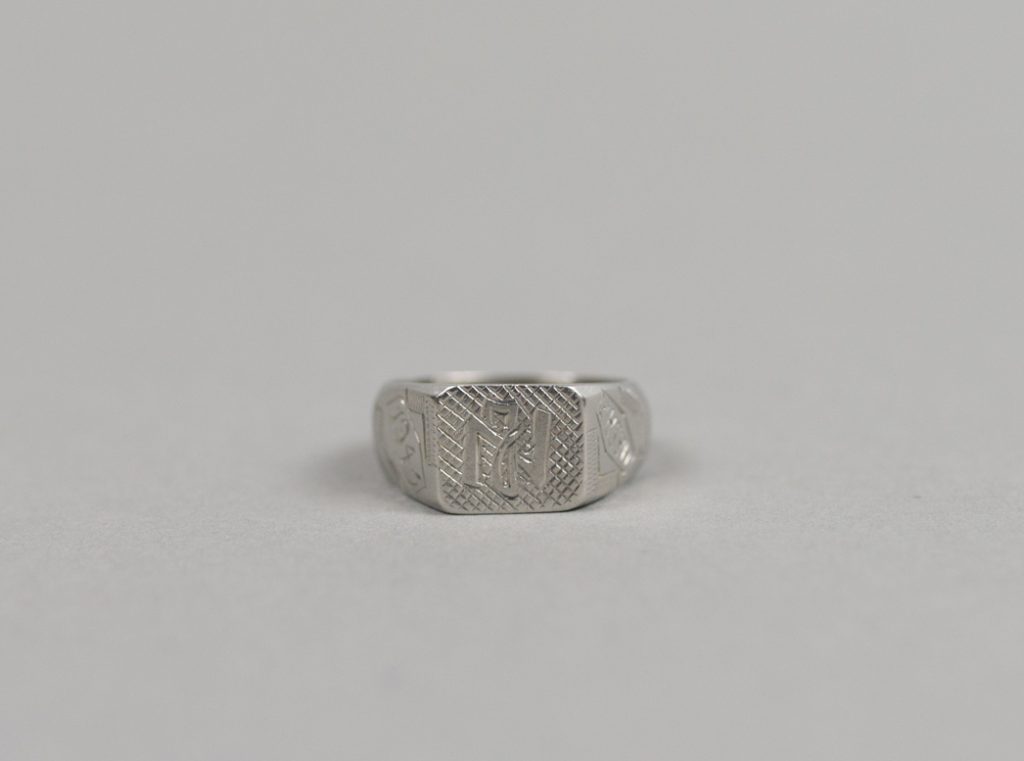By Robert McIntosh
| Name of the Artefact | Kennkarte for Rudolf Hahn | Ring |
| Creator | Nazi Government | Made by concentration camp inmates in HASAG forced labor camp |
| Date | 1939 | 1944 |
| Type | Identification card | Jewelry |
| Image |  | |
| URL | https://collections.vhec.org/Detail/objects/2014 |
Resistance and Refuge
Overview
One of the best ways to learn from events as tragic as the Holocaust is through the remaining artefacts of the atrocity. Artefacts are important as they serve as proof of an event that goes beyond the life of those who experienced the event firsthand. Preserving and sharing these artefacts is essential to remind us of the horrors of the Holocaust so we can avoid ever committing such vile acts against others again.
The ring artefact is particularly fascinating and somewhat unique in terms of its origin and even its existence. The ring itself is quite beautiful, made from a silver-coloured metal with fine detailing. The beauty of the ring is rather astonishing when one considers who made it and in what context. The ring was made by an inmate at the HASAG forced labor camp in Skarżysko-Kamienna, Poland for fellow inmate Sarah Rozenberg-Warm in 1944. HASAG was a German arms manufacturing company that used forced labor throughout the Holocaust, which explains how the craftsman was able to get access to the metal necessary to make the ring. However, as one can tell by the detailing, this was not made particularly quickly. Engraved on the ring is the date 1944, the HASAG company logo, and the initials JN (who, according to the Vancouver Holocaust Education Centre, made the ring). JN must have been very talented to make this ring secretly while he was being forced to make arms for HASAG. The unknown JN also made a comb for Sarah Rozenberg-Warm, but it was unfinished, which demonstrates the risk associated with its creation (see Figure 3). The intended use of the ring is unknown, though I will speculate on its use later in the paper.

The second artefact I found particularly interesting was the Kennkarte (identity card) belonging to Rudolf Hahn. A Kennkarte was a common identity document that was used in Germany during the Nazi regime. The document was created in 1939 by the Nazis for Rudolf Hahn as an identity card. Rudolf Hahn was required to carry one as a Jewish citizen. These cards were all written in German as the main objective was to allow German officers to be able to specify who was who. However, as one can tell, Rudolf Hahn’s Kennkarte specifies that he is of Jewish descent, as evidenced by the large “J” emblazoned on the document as well as the imposed middle name of Israel, which was forced upon almost all Jewish men to mark them as Jewish as of Aug 17, 1938. It also lists Rudolf Hahn’s birthday, place of birth, occupation, immutable marks and figure prints. This document is particularly interesting as it is an original copy on display at the Treasured Belongings: The Hahn Family & the Search for a Stolen Legacy exhibit at the Vancouver Holocaust Education Centre.
Meaning
The role of these two artefacts in the lives of the people who owned them is very different. In the context of the ring, one must assume that it mostly played the role of a means of hope within the life of the owner, Sarah Rozenberg-Warm. Being given such beautiful pieces of workmanship by a fellow prisoner must have been both flattering and scary. It must have been dangerous to have something that was made from pilfered materials at the HASAG factory. However, the fact that the creator of the ring, the unnamed “JN,” took the risk of making such a beautiful piece must have been very touching. The ring, as previously mentioned, was only one of a few things given to her by “JN.” She was also gifted a comb and a mirror, both practical items that would have been seen as luxuries in the Skarżysko-Kamienna camp.
The Kennkarte played a much clearer role in Rudolf Hahn’s life. As a Jewish citizen in Germany, he was required to carry this card. He had to complete a significant amount of paperwork to leave Germany. At the exhibit, Treasured Belongings: The Hahn Family & the Search for a Stolen Legacy,there is a great deal of detail about the role of Nazi bureaucracy in keeping the Jews in Germany. One example being the taxes and withheld assets that kept Rudolf’s father, Max Hahn, in Germany for so long, and which unfortunately led to his execution in Riga. Thus, for Rudolf, the Kennkarte would have been a reminder of the terrible things still occurring in his home country.
Symbolism
Origin
The artefacts I chose both have significant symbolic meaning. To me, the ring is a fantastic symbol of resistance in a time of extreme hardship. The symbol of resistance is due to the consistent theme of dispossession of belongings within survivor accounts of the Holocaust. For example, Hilde Sherman writes about the constant pilfering of valuables and the dispossession of goods both before and after being sent to the Riga Ghetto. First, Sherman describes how before their trip she and the fellow deportees “had to undress completely and our things were taken away. I had worn two or three layers of clothing because my mother had said: perhaps you will be able to keep the clothes that you have on your body.’ We never saw our suitcases again” (“From the Testimony of Hilde Sherman”). This behavior was mirrored by the guards after Sherman’s arrival at the ghetto when “The SS took all the valuables, rings, watches, chains and watched with lynx eyes that we did not let anything disappear.”[1] Käthe Anders shares a similar experience in her story of being sent to a concentration camp, noting that “I had a silver necklace with a cross, from my grandmother. It was all taken away. We weren’t allowed to keep anything.” [2] Keeping in mind how uncommon it was for the prisoners to be able to keep any possessions, not only was owning a forbidden item already an act of resistance, but creating a ring inside of a work camp was an even greater resistance. It is also worth noting that there is a particular aspect of resistance in the engravings on the ring, with the almost ironic use of the HASAG logo and the year on the ring, as though it were important to note the place where the metal for the ring had come from. The ring itself was useless in the camp, as Sarah Rozenberg-Warm could not have worn it out of fear of its discovery. However, its symbolic meaning of resistance is clear.
Rudolf Hahn’s Kennkarte had a very different symbolic meaning, even from its origin. At the time of the identification paper’s creation, it exemplified the ideals of racial superiority the Germans felt towards others. This is represented by the “J” stamped on the card and the forced middle name, both of which marked Rudolf as an “other” in the eyes of the state. Wendy Lower mentions this othering in Hitler’s Furies: German Women in the Nazi Killing Fields, saying “The scapegoating of “the Jew” in a time of severe crisis was, of course, nothing the Germans invented, though the centrality of this “other” in Nazi ideology was distinctive” (Lower 37). This forced identification of the “other” symbolizes the overt racism that Rudolf and his family would face in the coming years after 1938, where it would become commonplace to teach children that “the Jews were ugly not only on the outside, but on the inside too” (39). Luckily for Rudolf Hahn, he was able to escape Germany before he was forcibly relocated or killed. However, the Kennkarte was probably an excellent reminder of the type of systematic racism he was fleeing from.
[1] Translation of Hilde Sherman, Zwischen Tag Und Dunkel. Mädchenjahre Im Ghetto, by Uma Kumar, University of British Columbia, 2019.
[2] Translation of Käthe Anders, “Nie gelebt,” by Uma Kumar and William Orr, University of British Columbia, 2019.
Aftermath
It is challenging to properly assess how other people may believe artefacts from their past have changed in meaning over time. I have no idea how either Rudolf Hahn or Mrs. Rozenberg-Warm dealt with the trauma they faced at the hands of the Nazis, and I think it would be insensitive to assume how their feelings towards these items have changed over time. However, I can assess them as historical items alone and guess why the survivors may have donated these artefacts to be studied by future generations.
In the case of Mrs. Rozenberg-Warm’s ring. I believe in many ways its symbolic value stays the same. It remains a symbol of resistance against oppression and inhumane treatment. However, today I believe it also symbolizes the resilience of those who were imprisoned. An item such as the ring, which was made under such tragic circumstances, shows that one can survive even the hardest times and still retain some semblance of self. It also represents the kinship between those who survived (and even those who did not) as it reminds us of the selfless and courageous act of making the ring despite the extreme danger it would have put “JN” in.
In terms of Rudolf Hahn’s Kennkarte, the symbolic meaning of it has changed significantly. Firstly, the Kennkarte symbolizes the injustice that was done against Rudolf and his family, simply because of their categorization according to Nazi ideology. It represents the loss of his parents and his childhood home at the hands of a tyrannical regime. However, it also represents the unending desire for justice that the Hahn family still holds onto as they continue to search for their stolen heirlooms. The booklet still has a significant meaning to the Hahn family, and the Kennkarte has remained in excellent condition in its original format for years, showing that it has been treated with care and not simply discarded as an item from a past they wish to forget. However, the Kennkarte, like the ring, can now be seen by many others and can be used to draw awareness to the horrors that occurred, which hopefully will help us never repeat them.
Works Cited
Anders, Käthe. “Nie gelebt.” Ich geb Dir einen Mantel, daß Du ihn noch in Freiheit tragen kannst, edited by Karin Berger, Promedia, 1987, pp. 97-106.
Comb. 1944. Vancouver Holocaust Education Centre. https://collections.vhec.org/Detail/objects/2017.
Ring. 1944. Vancouver Holocaust Education Centre, https://collections.vhec.org/Detail/objects/2014
Lower, Wendy. “The East Needs You: Teachers, Nurses, Secretaries, Wives.” Hitler’s Furies: German Women in the Nazi Killing Fields, pp. 32–74. Houghton Mifflin Harcourt, 2013.
Sherman, Hilde. Zwischen Tag Und Dunkel. Mädchenjahre Im Ghetto, Ullstein, 1989, pp. 35–41.
“From the Testimony of Hilde Sherman about the Deportation to Riga and the Arrival to the Ghetto.” Yad Vashem Archives, The International School for Holocaust Studies, https://www.yadvashem.org/odot_pdf/Microsoft%20Word%20-%203287.pdf. Accessed 07 May 2020.
Treasured Belongings. The Hahn Family & the Search for a Stolen Legacy. 8 Nov. 2019 – 27 Nov. 2020, Vancouver Holocaust Education Centre, Vancouver.



Comments by Amanda Grey